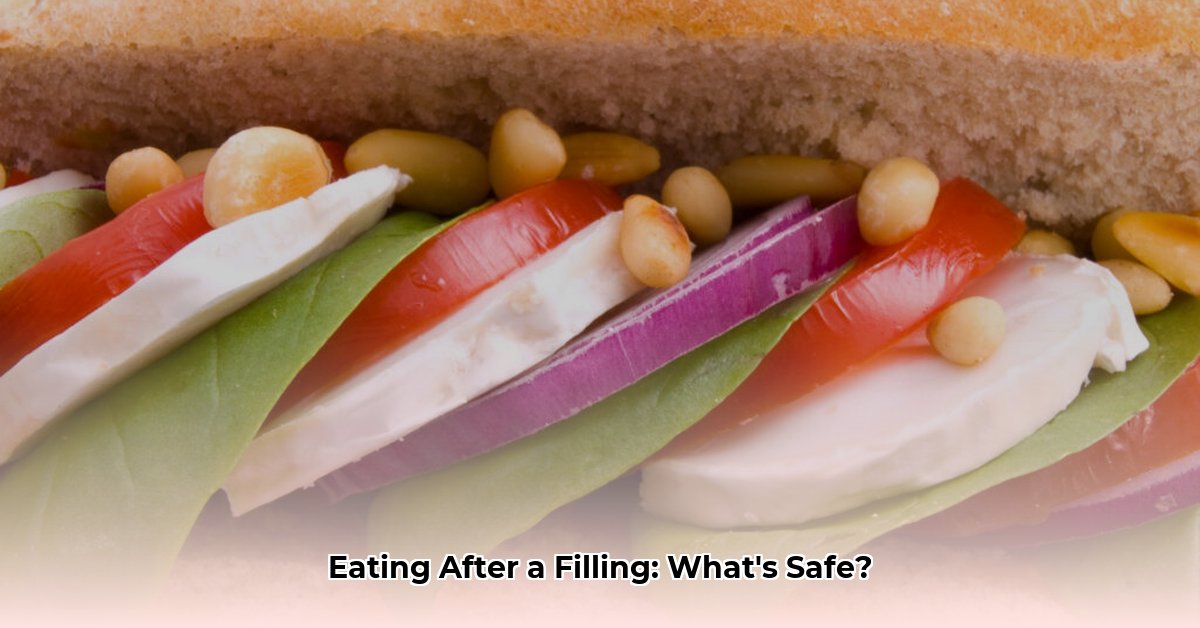Getting a filling is a common dental procedure, and you’re likely eager to get back to enjoying your favorite foods. This guide offers a comprehensive overview of what to expect after a filling, addressing common questions and concerns.
Post-Filling Feast: A Quick Guide
Yes, you can usually eat after a filling, but when and what you eat depends on the type of filling.
| Filling Type | Wait Time Before Eating | Initial Food Recommendations |
|---|---|---|
| Composite (White) | Often immediately, or after numbness subsides (1-2 hours) | Soft foods, lukewarm temperatures |
| Amalgam (Silver) | About 24 hours | Soft/liquid foods, avoid chewing on the filled side until fully set |
| Other (Gold, Porcelain) | Follow your dentist’s specific instructions | As recommended by your dentist |
Understanding Your Filling and its Impact
Different filling materials have varying setting times. Composite fillings harden quickly with a special light, much like super glue. Amalgam fillings require more time to set, similar to cement. This difference dictates when you can comfortably eat.
Numbness, Sensitivity, and Bite: Navigating the Aftermath
After your filling, you might experience:
- Numbness: This is a temporary effect of the local anesthetic. Avoid eating until the numbness wears off (usually 1-3 hours) to prevent accidental biting.
- Sensitivity: Your tooth may be sensitive to temperature or pressure. Lukewarm foods and drinks are your best bet initially.
- Bite Adjustments: Your bite might feel slightly different. This is usually normal and resolves as you adjust. If it persists, contact your dentist.
Step-by-Step Guide to Eating After a Filling
- Start Soft: Begin with foods like yogurt, mashed potatoes, or scrambled eggs.
- Mind the Temperature: Avoid very hot or cold foods and drinks.
- Chew Carefully: Favor the side opposite the new filling initially.
- Listen to Your Tooth: Stop if you experience pain or discomfort.
- Gradual Reintroduction: Slowly add other foods, starting with softer textures.
The “Yes” List and the “No” List: Choosing Your Post-Filling Foods
Foods to Enjoy:
- Soft and Smooth: Yogurt, applesauce, smoothies, pudding, soups.
- Gentle Proteins: Soft-cooked fish, scrambled eggs, tofu.
- Comforting Carbs: Oatmeal, mashed sweet potatoes, well-cooked pasta.
Foods to Initially Avoid:
- Crunchy: Chips, pretzels, hard candy, nuts, crusty bread, ice.
- Chewy: Caramel, gummies, taffy.
- Sticky: Toffee, dried fruit.
- Extreme Temperatures: Ice cream, very hot coffee or tea.
- Sugary/Acidic: Candy, citrus fruits. It’s also advisable to limit alcohol and carbonated beverages for the first 24 hours. Research suggests these can interfere with the bonding process of some fillings.
Managing Sensitivity and Discomfort
Some sensitivity is normal. Try:
- Warm Salt Water Rinse: This can soothe gums.
- Over-the-Counter Pain Relief: Ibuprofen or acetaminophen can help manage discomfort.
- Sensitivity Toothpaste: This can help reduce sensitivity over time.
When to Contact Your Dentist
While most fillings settle in without a hitch, contact your dentist if you experience:
- Severe or persistent pain
- A loose or dislodged filling
- Persistent bite problems
- Swelling or excessive bleeding
Long-Term Filling Care
Maintain good oral hygiene:
- Brushing and Flossing: Twice daily brushing and daily flossing are essential.
- Regular Checkups: See your dentist for regular checkups and cleanings.
- Dietary Habits: Limit sugary and acidic foods and drinks.
While current research supports these practices, ongoing studies continue to refine our understanding of optimal oral hygiene techniques.
Frequently Asked Questions (FAQ)
Q: Can I drink water after a filling?
A: Yes, you can usually drink water after a filling, preferably at room temperature.
Q: How long will my filling last?
A: The lifespan of a filling varies depending on the material, your oral hygiene, and dietary habits. They typically last several years, but regular checkups are essential for monitoring their condition.
Q: Will my insurance cover the cost of a filling?
A: Most dental insurance plans cover a portion of the cost of fillings. It’s best to check with your specific provider for details.
Q: What are the signs that my filling needs to be replaced?
A: Signs include pain, sensitivity, a chipped or cracked filling, or a noticeable gap around the filling.
Q: Are there alternatives to fillings?
A: In some cases, alternative treatments like inlays, onlays, or crowns may be recommended depending on the extent of the damage. Your dentist can discuss the best options for your individual needs.
This guide provides general information. Always consult your dentist for personalized advice regarding your specific situation. They can offer the most accurate and up-to-date information based on current research and your individual needs. While dental technology and practices are constantly evolving, your dentist’s expertise remains your best resource.
- Adult Bento Box Lunch Ideas For Quick Healthy Portable Options - December 25, 2025
- Adult Bento Meal Ideas for Delicious, Easy, and Healthy Lunches - December 24, 2025
- Adult Bento Box Ideas for Delicious and Easy Lunches - December 23, 2025










